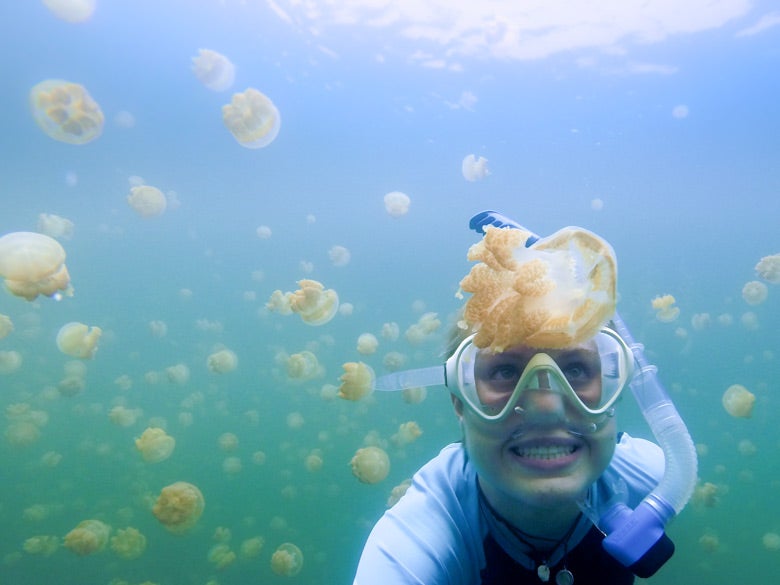
Undergraduate Meghan Shea, a fellow in the MUIR program, examines jellyfish during her summer fieldwork off the Pacific island of Palau. (Image credit: Meghan Shea)
For a common question – What did you do over the summer? – Meghan Shea has an uncommon answer. The Stanford undergraduate spent the dog days conducting field research aimed at finding a solution to one of the world’s most pressing environmental issues.
Shea and her fellow researchers analyzed how seagrass communities off the Pacific island of Palau help buffer nearby corals against ocean acidification, a process driven by increasing levels of atmospheric carbon dioxide that threatens sea life. They gathered information through analysis of water currents and temperatures, as well as sediment and marine life sampling,
Shea’s work was funded through the Mentoring Undergraduates in Interdisciplinary Research (MUIR) program, which supports interdisciplinary environmental research by Stanford faculty by providing summer stipends for undergraduate student researchers. MUIR is funded by the Vice Provost for Undergraduate Education (VPUE) and the Stanford Woods Institute for the Environment, and organized by Woods. The program aims to ensure solutions-focused research provides hands-on knowledge and formative experiences for future innovators.
One of those formative experiences for Shea, an Environmental Systems Engineering major, came while she was working with a researcher from the Palau International Coral Reef Center.
“He could get into the water at any of our field sites and, in a manner of seconds, list off the scientific names of all of the seagrasses, invertebrates and fish there,” Shea said. “I learned more in 30 minutes about marine species than I think I have learned in all my prior years of snorkeling and scuba diving.
“It exemplified one of the best parts of working in the field – learning and working with people who know the environment much better than you.”
Past MUIR projects have looked at challenges such as improving economic outcomes for cacao farmers in Central America and detecting influenza emergence in migratory birds.
“Through the MUIR program, I was able to tackle a familiar problem – climate change – from a social sciences and policy perspective, and therefore add variety and depth to the repertoire of analytical skills I’ve already developed in my core classes,” said Mark Carrington, a 2014 MUIR fellow who explored media impact on perceptions of climate change.
This year’s MUIR fellows worked on projects ranging from studies of rain-fed agriculture systems in Hawaii to the persistence of uranium contamination in the Colorado River, to analyses of an online energy and environment behavior change program and sustainability’s role in business school educations.
Nick White, an electrical engineering major, spent the summer working on disease ecology simulations and intervention strategies for a Stanford-led project to enlist freshwater prawns in the battle against a parasitic disease in West Africa.
“I never would have thought that I could apply my electrical engineering knowledge to this kind of work,” White said. “I think the MUIR program is unique in that the research projects directly address real-world problems and emphasize using knowledge from many fields to solve these problems.”
Rosemary Mena-Wirth worked in a bio-diverse region of Costa Rica teaching high school students about environmental issues, leadership, English and other skills. The intensive training was part of a community-focused approach to conservation that reconciles perceived conflicts between human prosperity and protection of natural resources. “It helped me understand how to humanize science, and how to help people realize their stake in these issues,” she said.
Summer is when faculty are most singularly focused on research programs. That makes it an ideal time for undergraduates – who are busy with full course loads during the rest of the year – to be involved in research and to receive dedicated mentoring.
“Faculty members gain talented students to work on critical environmental questions,” said Brian Sharbono, the Woods program manager. “Undergraduates gain exposure to the cutting edge of environmental issues, learn research skills on the job and receive mentoring from highly accomplished Stanford faculty.”
To prepare for the summer, MUIR students take an interdisciplinary research skills course. Following their summer work, students must present their research at a symposium.
Shea, who worked under the guidance of Rob Dunbar, the W.M. Keck Professor in the School of Earth, Energy and Environmental Sciences and a Woods senior fellow, is still pinching herself over the experience. “It was the type of project that would have been totally inaccessible to an undergraduate without the support and funding of the MUIR program,” she said.
Read more about funded projects.
Media Contacts
Rob Jordan, Stanford Woods Institute for the Environment: (650) 721-1881, rjordan@stanford.edu